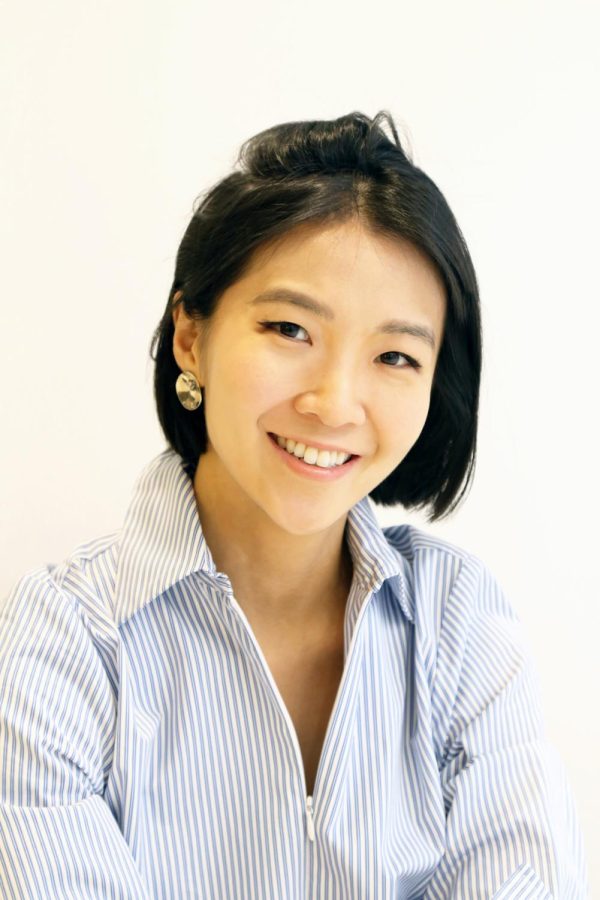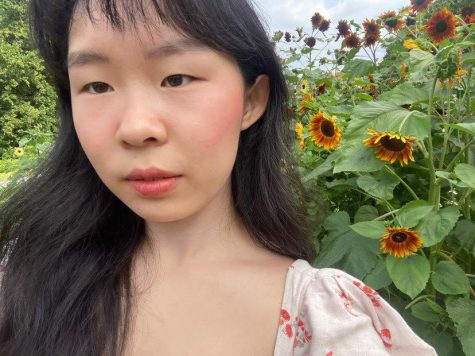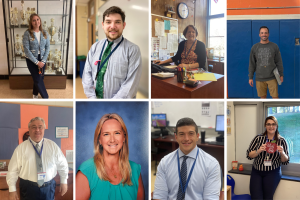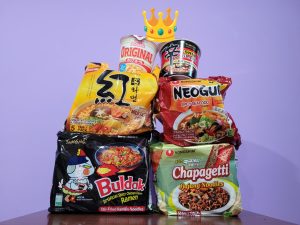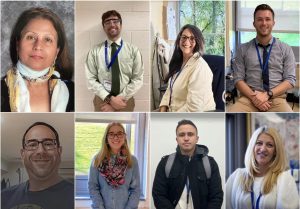Notable Alumni Interview Series #3: Grace Jun
Grace Jun (Class of ‘05) is the Chief Executive Officer of Open Style Lab and an Assistant Professor at the University of Georgia. She previously worked as a UX Designer at Samsung Electronics and taught at The New School and Parsons School of Design. She has been featured in Vogue, Forbes, New York Times, and the Washington Post, among others. Grace received her BFA in Graphic Design from RISD and her MFA in Design and Technology from Parsons.
April 13, 2022
Sophia Liu: How was your time at Great Neck South High School? When did you attend? What was your most memorable experience?
Grace Jun: I started in 2001. My most memorable experience was the cultural show, where everyone dressed up in their traditional outfits. I was part of something art-related that organized the publicity around it.
My best moments were in art class. Art and English were some of the biggest things that I looked forward to. I forgot if it was the student body or my art teacher that had encouraged me to design one of the yearly calendar notebooks, but I designed the cover, I think my junior year, with a bunch of whales swimming in space.
SL: Was there a teacher at South that particularly influenced you?
GJ: Ms. Orange, my art teacher. I met with her a few years after I graduated when I was in my first job coming back to the United States four to five years out of college. She was probably the most influential in a lot of my work. She introduced me to RISD, which I didn’t know of during high school. I applied thanks to her.
My English teacher also was influential. I learned Shakespeare in a different way because of him. I thought it would be a very boring subject, but he performed all of the scenes or asked the students to perform some of the scenes. That to me was a better approach than being told to read the next few chapters.
Another one of my favorite teachers was Mr. Ko. His class on European history really helped me contextualize art and design in a historical context for my liberal arts studies later at RISD.
SL: Can you talk more about your interest in English?
GJ: I liked writing from an early start. I wouldn’t say I was particularly good at it. But I liked writing. I was not the brightest in math or the sciences, but I loved physics for some strange reason. I think there were just some subjects that due to the faculty, I enjoyed more. And I liked it when I was not just challenged to learn, but there was something interesting about problem solving, or being able to express your thoughts in a different way.
SL: Did you take art in high school?
GJ: Yeah. I took it almost every year, every time I had a chance, and most of it was still-life drawing. The courses at South already kind of provided enough of what I needed to create a portfolio in order to apply for college. I also went to the Cooper Hewitt summer program. I felt that my portfolio was more diverse. I didn’t want them to all look the same, or have the same medium. And then, of course, I had to complete the test that RISD is well known for. I think I was well-prepared for it.
English and Art were the two subjects that I excelled the best in, but I also enjoyed. I was not a well-rounded student that was good at everything or trying to be good at everything. I was very stubborn.
SL: What was your art like at this time?
GJ: I did etching. The piece I made for the school calendar was etching, so it was black and white. It was my first time using negative space as a form of removal to produce art. Other pieces were simple, from either acrylic and oil painting, to collage here and there. I tried to articulate texture in some of my paint, pen, and pencil work. I found texture fascinating.
SL: After South, you went to RISD for undergrad. How was that transition and how did your time at RISD influence your work now?
GJ: The transition to RISD, especially since it was out of state, was a new experience. I’d never been to Providence, Rhode Island. RISD has a great liberal arts program, so I wasn’t doing traditional drawing all the time, but was able to explore art history and contemporary literature. I took some courses at Brown University for poetry, which were very enriching. As I look back on it, I realize how little I knew then, and I wish I knew more. I’ve learned to be a lot more comfortable with my drawings, myself, and my artistic pursuits after I graduated.
SL: Did you know you wanted to be a designer when you entered RISD?
GJ: I had no doubt that I wanted to be somewhere in the arts but wasn’t sure if that would be design. Other than myself, it was my parents that knew first. I had scribbled on the entire bathroom wall at a very young age and they figured that I should probably pursue something in art. It was an obsessive, obsessive drawing all over the wall. I thank them for noticing it earlier and being really supportive. I think some students may not feel that support through the arts, but I definitely felt very supported.
SL: Can you speak more about that encouragement? Culturally, being an artist isn’t what Asian parents envision for their children.
GJ: I think there’s a lot of hesitancy in the arts or things that are unknown from our parents’ generation. I can’t speak for every Asian American parent, but that’s the assumption I got from my peers.
I think my parents didn’t know how to articulate the specific disciplines in art. For example, they didn’t know the difference between fine arts or graphic design, but they cared that I was exploring and expanding with ideas. Art was one of the only subjects I would spend hours hunched over trying to finish, even in the late night without anyone’s prompt, or anyone saying, Oh, you need to do this. They recognized that very early on and saw that I was driven.
I found that the more I described what that uncertainty was to my parents, they developed some anxiety, but also more clarity on what could be a possible career choice. If they heard that the local newspaper was hiring a cartoon artist, they encouraged me to apply and I would respond, No, that’s not my thing. But thanks for thinking of me.
It started to slowly develop there, and I’m lucky to have a good relationship with my parents. Interestingly, I think because my father studied engineering, he saw the sciences as intrinsic to art and he also loved drawing. My mother loves art history. She took courses in architecture when she was in college, so she wasn’t a total stranger to art. She tried to take me on a European history trip for all the arts, but it went by so quickly because I was so young at the time that I don’t think I really appreciated it. She was supportive as well.
SL: You mentioned you felt you knew nothing when you were in college. What does that mean? What do you know now?
GJ: I wasn’t as equipped to apply my skills into the workforce. Slowly, I started to gain experience from my internships at Tiffany & Company and Cosmopolitan Magazine. I thought I wanted to be in fashion editorial. This is why internships are so important because I realized I didn’t enjoy what I was doing early on.
Now, I think more holistically because when you’re at a company, you’re not only working with your team, but you need to consider marketing, legal, and other facets about business. I learned a lot more about business after college.
I had a wonderful teacher named Bill Foulkes who graduated from Harvard Business School and taught at RISD. He sparked my interest in business and design.
SL: You majored in Graphic Design at RISD and Design and Technology at Parsons. How did you choose these majors and how did they lead you to the Open Style Lab?
GJ: My majors are not directly linked to OSL. I think the artistic or creative experience is something that’s not linear, and I never expected to be doing what I’m doing. I chose graphic design because I simply love the way words and images were composed on a page, whether that is a web page or print. That led me to my first job at Samsung Electronics doing user experience when it was rising to a booming design position for mobile cell phones. My last project at Samsung was on wearable watches, which bridged the intersection between fashion and graphic design. I knew at that moment I wanted to go back to school and make my own designs.
I left and went to Parsons for their Design and Technology program. Part of my thesis was making a jacket for a woman who had breast cancer surgery and tracking her movement onto an iPad to inform her physical therapist. It was an ambitious project and a way of putting everything I knew and my interests together.
I had been researching wearable technology prior to 2012, beginning at Samsung. I came across Open Style Lab which first started as a public service project in 2014. When I came back to the States, I decided to reach out to a few of the people who were developing the project at the time and they happened to be in New York. The rest was history. I served as a researcher when OSL was still a lab at MIT and then became its executive director. I saw the potential of OSL.
SL: Your work at Samsung was in Korea, right?
GJ: Yes. That was big. My first full time job was in South Korea for about five years.
SL: Was that a choice you made?
GJ: When I was interviewed, I didn’t realize they had asked me if I wanted to potentially work overseas and that I had said yes. I just said yes to everything. I ended up going. My parents still had family there. And I figured if I was going to try to work in a different country, doing it while I’m young is probably preferable. Because I didn’t read or write Korean, it was a very different environment for me.
SL: What sparked your interest in accessibility? How did you decide to devote your work to social inclusion?
GJ: The first thing was thinking about experiences of disability. I have had several temporary disabilities. Most recently, I’ve lost my voice for half a year after surgery. Try teaching during a pandemic, when you have no voice. It’s quite the ride. But it also means you have to adapt and think about new solutions on how to articulate and communicate. I’ve also experienced physical disabilities which made clothing constraining.
I realized early on that great design bettered people’s lives and that is a value I hold dear. I didn’t know how that would turn out, but it was my goal. Afterwards, I found the right community and good friends. It took a long time. Even at RISD, I was always interested in something that was community-driven, and tried to find ways to relate to different groups and different people.
SL: At Open Style Lab, you observe individual clients for weeks and tailor your product to their circumstances. Do you have an especially notable memory of working with a client?
GJ: I’ve worked on collaborating with people with a disability not just through Open Style Lab but also the courses I have taught while I was a professor at Parsons. One of the most memorable is the collaboration we did while I was a faculty at Parsons with Christina Mallon. She is one of my best friends and also my bridesmaid from my wedding last year. My students designed a coat she would be able to put on by herself in the winter, since both of her arms have paralysis because she has ALS. That’s the most memorable to me because of Christina and how I’ve been able to develop a really special relationship with her.
SL: Can you take me through your design process?
GJ: It stems from observation. I’ve been trained in a more industrial way where observation is key. I take a long time synthesizing, note taking, and iterating or sketching based on observation before I try to approach creation. Through observation, we can engage in co-design, participatory design, and inclusive design. Then there is material exploration. Understanding the choices of your materials, the limitations of the materials, and its sources is really relevant for fashion, especially since sourcing fabrics and understanding how fabrics behave is key to understanding
SL: Are some processes more challenging?
GJ: I wouldn’t say challenging, but they face different challenges. There are many different outlines for the way people work or design together.
SL: I’m intrigued how Open Style Lab not only hires designers, but also therapists and engineers. Why do you find collaboration among the STEAM fields necessary and how has bringing in different perspectives aided in the success of OSL?
GJ: Our mission is to make style accessible through design and technology. Many studies around adaptive fashion for people with disabilities incorporate the lens for occupational therapists and how they make sure that clients could achieve bodily activity. Engineering and material sciences like electrical engineering are valuable for wearable technology and you see that in prosthetics and other connected devices for people with disabilities. It’s important because we’re not a disability organization like the Cerebral Palsy Foundation. We first and foremost work in design, but with a multidisciplinary lens.
SL: You noted in a NEA podcast that designing is about bodily empowerment. Can you speak more about that? How has fashion facilitated self-esteem in your personal life and in the lives of your clients?
GJ: I’m glad you listened to that. One of the ways fashion can be empowering is through freedom of expression. For example, you’re looking for a uniform that is designed for someone who’s a wheelchair user. If that’s not available, then that limits their choice and their right to have clothing that fits for the workplace or in society. Ultimately, it’s empowering because fashion facilitates people being able to participate in society.
Another example is wedding dress shopping. Imagine no designs take into consideration a catheter, something that is attached through a tube for urination. Many wedding dresses are designed without disability in mind, nor are they designed for various body types in a way that is accommodating for posture. When there is a lack of accessible clothing, it prevents people from participating in social events where there are dress codes, such as weddings, funerals, or the workplace.
SL: OSL published the book Universal Materiality, which showcases your projects. What do you hope to accomplish with this book?
GJ: That was co-published by myself and Dr. Jeanne Tan and it covers some of the Open Style summer programs and Dr. Tan’s research. It serves as a set of examples of wearable solutions that were developed over the summer through our research collaboration.We explored how electronics could be applied for the body with elderly long-term residents with disabilities at a rehab center.
I’m currently writing my own book as well, which will be launched next fall of 2023 on inclusive design and adaptive fashion. It’s a culmination of the last six to seven years of my work in design.
SL: How was assuming leadership at Open Style Lab, and where do you see OSL in the future?
GJ: I hope that OSL will still be able to connect and foster unity. Over the pandemic, we held a lot of online workshops with different disability groups. We spoke to a school from Eastern Europe. They found us and we wanted to connect and do something together. The pandemic helped us expand more internationally because a lot of people with disabilities have transportation barriers to participate in-person. Due to online interaction and learning, our company was opened to more opportunities. I hope we continue to build those relationships.
Nonprofit management and operations is quite different from For-Profit management. I dived in and learned the hard way. I did not learn it at school. I thought, Okay, I have to file, here are some legal papers, how do you incorporate in another state, what are taxes, etc. and I started to build my knowledge that way. I asked a lot of people. I think putting yourself out there shapes the type of leader you will be. I reached out to as many people as I could the first five years of my career starting with OSL. By putting yourself out there and developing relationships, you’d be surprised by what you’ll learn. You get to ask other people how they manage their company. Most importantly, leading a company is not just doing the accounting or having a design vision, but understanding and managing people.
SL: Do you envision taking your products to market?
GJ: No, we never thought of OSL as a production, but rather an incubator space to foster why there’s a lack of knowledge of inclusive design. I wouldn’t say we’re product driven, but we do have some merchandise that people can buy. Recently, we launched a tote bag designed by one of our disabled creators. We are having some wearable technology merchandise, but that’s not our goal. It’s more about how to provide educational experiences where people have a space to design. It seems like most people don’t know where to begin, so we wanted to provide a crash course on how to collaborate and co-design with different disability groups because there’s not many other places that focus on this.
SL: You also teach at the University of Georgia. Did you intend to become a teacher?
GJ: No. I didn’t think I would ever be in academia, which is really lovely. Wherever you think you’re taking your career, always be open. I developed the educational program at OSL at MIT. That was my first time designing a curriculum. For me, I didn’t know at that time I was teaching. I just told myself I needed to develop the syllabi for the program.
Then, I taught part time at Parsons and became full time quickly. Finally, after five to six years, I’m here at the University of Georgia. I’m glad to say I’m back in the Graphic Design Department because I think interactive design is more along the field of where I want to practice my research. It leverages more of my professional work from Samsung that I give to students. I’m also teaching seniors now, so I hope I can prepare them to graduate
SL: Teaching is another self-taught endeavor for you.
GJ: Yeah. I always thought if I wasn’t learning, I was not doing right. I constantly want to be stimulated, learning, and improving. Education helped my curiosity become satiable.
SL: How do you balance teaching with OSL?
GJ: OSL is better self-run now than when I first started. We’ve been around for seven years, so it’s been great having more people join. My goal last year was to hire 70% of our team from people with disabilities. And I accomplished that. That’s all that matters to me other than budgeting and financing. It’s manageable because they can lead with their own projects and I still provide some vision and guidance. The pandemic largely helped in rethinking about remote educational experiences.
SL: Do you see yourself continuing to teach?
GJ: I don’t know, that’s a very tough question. So far, I’m enjoying it and I think I’ll still be teaching one form or another. To me, as long as I’m learning, I’m okay. I have trouble just sitting still. There’s always something for me to do as long as there’s a space for me to interact with people and find interesting ways to learn.
SL: Your wedding seemed like the perfect culmination of your experiences in accessible design. In what ways has accessibility been integrated into your personal life?
GJ: Recently, I had a voice amplifier which I still use in classes. I was trying to redecorate and redesign the strap. It was uncomfortable and probably too thick and the material was not adjustable. That was my own small pet project so that I can amplify in a classroom without straining my voice.
I’ve also been experimenting through graphic design such as print digital work that can be more accessible such as screen and image captioning and embossed print. Primarily, I’m focused on finishing my book by this winter so that I can send it to my publisher so it can go for review for next year.
SL: Your work is not only about accessibility, but helping people who have been historically alienated and neglected from popular culture. How has the meaning of inclusion changed for you through your work?
GJ: It has definitely changed from each person I’ve talked to to the more I learn. I reread certain works about design and disability that have shaped my perspective of what is inclusive design.
For me, inclusion is about putting the person with a disability at the very start of a creative endeavor and having them drive the design process. I’ve experimented through my classes and summer programs. Each summer program has a different research topic and the classes involve different disciplines of art from sculpture to fine arts to architecture to communication design. It wasn’t your typical 3 tier group I developed as a process at OSL.
SL: What do you hope to see in the design industry as a whole in terms of including people with disabilities?
GJ: I hope that design positions in larger companies include more people with disabilities not as a charitable option, but to look at it in an innovative way to produce things. It’s complex. Not even people with the same disability are alike. There is no one size fits all, but there is an inclusive way in bringing people with disabilities to design practices and therefore creating more products and services with disability in mind.
Previous technological inventions were designed by people with disabilities or with them in mind. For example, the Levi Jeans in the 1960s were by a designer with a disability. It’s not something new, but I hope it will become more mainstream.
SL: What advice would you give to high school students, young artists, or anyone in the process of figuring out themselves and their future?
GJ: There’s a lot of anxiety from students in part from so many options. Back then, we didn’t have social media. Because you all have so much access, it could be overwhelming. I would recommend for students to find your own safe and quiet space where you feel creative and balanced to think about your own approaches. Have conversations with people. Develop relationships. That doesn’t happen overnight. That happens over time, sometimes not as smoothly as you like, but it’s all part of the learning process. I hope that you develop good relationships with your peers and have your own space to feel comfortable, loved, and appreciated to foster your own creativity. I think if you’re constantly distracted by something or not in the best environment, it’s really hard to think of creative work. If you keep working hard, there will be good timing. When the opportunity comes for you to apply your skills, you’ll be ready.
SL: Lastly, can you talk about your book and other projects you’re working on?
GJ: My book looks at adaptive fashion and inclusive design. What does that process look like and what were the challenges related to previous studies around functional clothing and other studies in other disciplines such as assistive technology and occupational therapy? There’s a lot of pictures and many of them are from my past students and clients. It’s a culmination of everyone I’ve gotten to know as well as my own approaches to how I’ve taught and designed methodology. It will be published by Bloomsbury next year—the same publisher that published Harry Potter. It’s more of an instructional book for creative designers or anyone thinking about how to get started.


